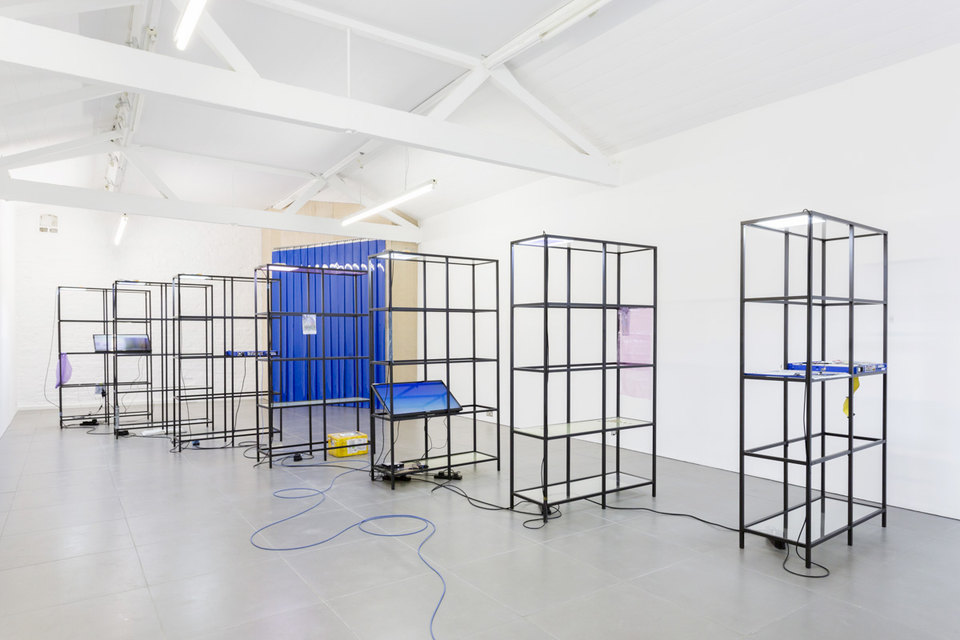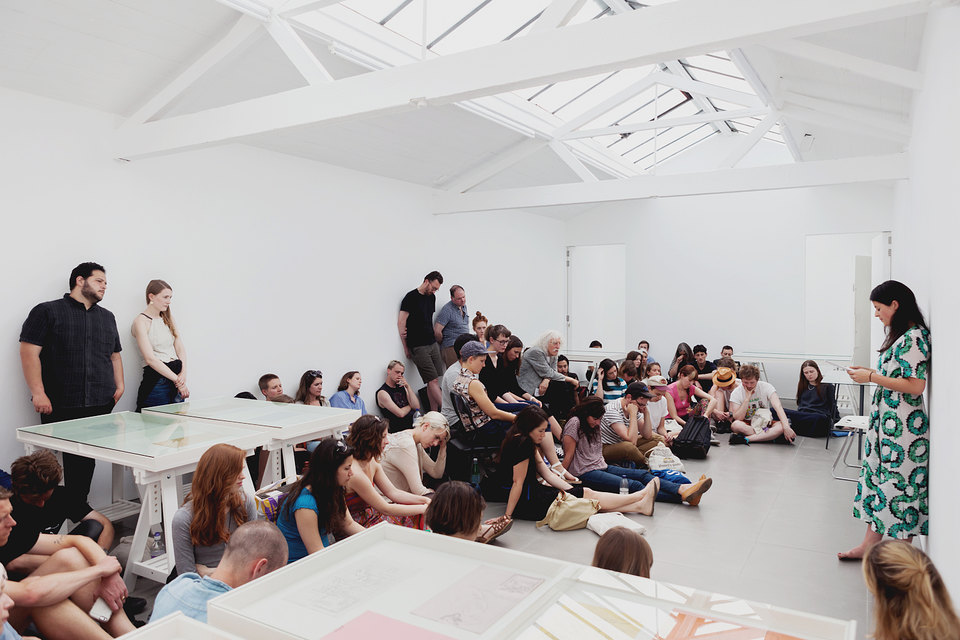

20 Year History
Founded in 1999, Cell Project Space was built by artists Milika Muritu & Richard Priestley, who remain as the senior directors of the organisation. Originally located in a run-down former Victorian furniture factory in Tyssen St, Dalston, Cell began as 12 artists’ studios and a small artist-run project space alongside it. Initially set up as a testing ground for artists to take risks, initiate new conversations, and to challenge the status quo around exhibition formats, the space was formed in the wake of buoyant market forces that took hold in the early 2000’s. Due to the site’s redevelopment in 2001, Cell moved into what was once a run-down and deprived area of Dalston, to ‘Ideal House’, Arcola St; a dilapidated former textiles factory, where a five-year lease enabled the studio provision to be expanded, generating greater sustainability for the gallery and its programme, giving rise to ambitious collaborations, on and offsite, including with MAMA Showroom; Rotterdam, Serpentine Gallery; London, Cooper Gallery, Dundee; Blank Projects, Cape Town; and a commissioned project for the 6th Sharjah Biennial.
The programme at Ideal House comprised group projects, combining both emerging and internationally recognised artists working against a backdrop of East London’s looming gentrification and an anticipation of the new growth in global art markets. Both directors collaborated with the support of fellow practitioners and educators, curating projects including artists Reza Aramesh, Fiona Banner, Kathrin Böhm, Matt Franks, David Burrows, Sean Cummins, Matt Franks, Liam Gillick, Richard Hughes, Graham Little, Goshka Macuga, Paul O'Neill, Simon Patterson, Gail Pickering, Alex Hidalgo, Giles Round, John Russell, Gavin Turk, Francis Upritchard, Gavin Wade, Emily Wardhill, Annie Whiles and Toby Zeigler.
In 2003, the gallery and HQ relocated to our current Bethnal Green site, on Cambridge Heath Rd, building and nurturing a hugely treasured adjacent public green space, alongside a recent new addition of a ground-floor multi-purpose event space, opened in the summer 2019.
The gallery has seen many transformations throughout its 20-year history, collaborating and supporting several generations of artists. Over the last two decades, Cell Project Space has worked with over 300 artists, including: Caroline Achaintre, Kathy Acker, Rosa Aiello, Patricia L. Boyd, Athanasios Argianas, Lee Yong Baek, Zuzanna Bartoszek, Simon Bedwell, Jenna Bliss, Nicolas Deshayes, Ellen Cantor, Mathias Faldbakken, Loretta Fahrenholz, Angharad Williams & Mathis Gasser, Celia Hempton, Kim Coleman & Jenny Hogarth, Shaun Gladwell, Wade Guyton, Pierre Klossowski, Nick Laessing,Carolyn Lazard, Liliane Lijn, Sam Lipp, Gili Tal, George Henry Longly, Rory Macbeth, Ursula Mayer, Haroon Mirza, Adrian Piper, Magali Reus, Ben Rivers, Józef Robakowski, Donald Rodney, and Ross Sinclair.
In 2011, Cell launched 'Cyclorama', the first in a new year-long series of commissioned solo projects that established the role of the gallery as an exploratory space to develop knowledge and practice at a pivotal point in an artist’s career. The project launched a new approach for the gallery, galvanising collaborations with institutions and funding partners, which enabled artists to produce their most ambitious body of work to date. Cyclorama’s alumni include Benedict Drew, Eddie Peake, Angelo Plessas, Mark Aerial Waller and Jessica Warboys.
Adjunct to the exhibitions programme, Cell launched ‘Cycle Club’, a reactive initiative that hosted a series of supportive events, which placed moving image in the context of rapid changes to digital technology. ‘Cycle Club’ celebrated the work of a new generation of practitioners, researchers and curators, hosting a range of nomadic and adjunct projects such as Elise Lammer’s ‘Hotel Palenque’, that sited artist, Hannah Perry, nostalgically staging the ‘death’ of analogue media by presenting a recording of the progressive disappearance of a moving image; and Evan Ifekoya's workhop HOT SPOT, for young people using the digital cloud as a starting point to produce a visual language of resistance. A seminal panel discussion punctuated the programme; ‘Cult of The Amateur’, chaired by curator Sarah McCory, hosted discussions with Rosza Farkas, Tom Clark, Will Jarvis, Attilia Fattori Franchini and João Laia, and underpinned the critical potential of the internet’s activity to date.
With the legacy of this programme, solo exhibitions became an important component of gallery activities, working with artists including Jonathan Baldock, Anna Sophie Berger, Celine Conderelli, Mimosa Echard, Peles Empire, Julia Crabtree & William Evans, Adham Faramawy, Eglė Kulbokaitė & Dorota Gawęda, Emma Hart, Ghilsaine Leung, Alan Michael, Beatriz Olabarrieta, Aude Pariset, Yuri Pattison, Mick Peters, and Barbara T Smith. ‘Cycle Club’ ended in 2013 but, as a result, it formalised Cell’s longstanding public programme, which today continues to run alongside the exhibitions, providing a platform to develop new research, discussion, workshop, test ideas and present preliminary studies of work. Highlights include events such as ‘Jenkins, Moore and Bird’ (2014), a reading by Keston Sutherland published later in 2015; ‘Sets Of Poetry’ with contributions by Sophie Collins, Kathy Noble, Megan Rooney (2015); and a a range of one-off performance contributions by artists including Harriet Middleton-Baker, New Noveta, Celia Hempton, Juliana Huxtable and Alex Baczynski-Jenkins, amongst many others.
Founder and Director Richard Priestley has been pivotal in developing financial sustainability for the organisation, negotiating with local authorities, the GLA and Creative Land Trust on a consultative and advisory basis in areas including regeneration, area master planning and Section 106 strategy to preserve affordable creative workspace; work that has enabled Cell Studios to currently operate six sites across East London, generating income for the gallery in perpetuity, enabling Cell to build exhibition reserves and a permanent curatorial team.
Since 2011, the gallery programme has been shaped by director and programme curator, Milika Muritu, alongside an array of fellow thinkers, including collaborations and projects with curators Rebecca Lewin, Laura McClean-Ferris, Attilia Fattori Franchini, Morgan Quaintance, Tobias Czudej, João Laia, Femke Oortwijn and Elise Lammer. In 2016, Tim Steer became the gallery’s first associate curator (2016-2019) curating pivotal solo exhibitions by Ghislaine Leung  and Anna Sophie Berger and the highly acclaimend group exhibition Perverts which cited works by Kathy Acker, Zuzanna Bartoszek, Harry Burke, Loretta Fahrenholz, Pierre Klossowski, Juliana Huxtable, Bruce Nauman, Keston Sutherland & Stephen G. Rhodes. Rachael Davies joined as gallery manager (2016-2020) and later became public programme curator (2019-2020), who developed the Schema series which recognised expanded artistic practices by connecting artists, writers and academics with new audiences through workshops, events and performance. Schema presented some important development work for artists including Ayesha Tan- Jones, Monique Etienne, Sean Roy Parker and Harriet Middleton-Baker. During 2020-2021, Eliel Jones was appointed as associate curator, who developed an online and mail art initiative to reaccess the gallery's output during extended periods of lockdown during the global pandemic COVID-19 and launched Cellular an experimental multi media platform and residency programme which started the gallery's first initiative to cultivate and commision new works, site specific for the galley's new event space.
and Anna Sophie Berger and the highly acclaimend group exhibition Perverts which cited works by Kathy Acker, Zuzanna Bartoszek, Harry Burke, Loretta Fahrenholz, Pierre Klossowski, Juliana Huxtable, Bruce Nauman, Keston Sutherland & Stephen G. Rhodes. Rachael Davies joined as gallery manager (2016-2020) and later became public programme curator (2019-2020), who developed the Schema series which recognised expanded artistic practices by connecting artists, writers and academics with new audiences through workshops, events and performance. Schema presented some important development work for artists including Ayesha Tan- Jones, Monique Etienne, Sean Roy Parker and Harriet Middleton-Baker. During 2020-2021, Eliel Jones was appointed as associate curator, who developed an online and mail art initiative to reaccess the gallery's output during extended periods of lockdown during the global pandemic COVID-19 and launched Cellular an experimental multi media platform and residency programme which started the gallery's first initiative to cultivate and commision new works, site specific for the galley's new event space.
After two decades, Cell has continued to stay financially independent and in the margins of a growing professionalised art-world, finding strategies to financially support several communities of artists who have not yet benefited from wider critical, curatorial or commercial attention. Cell's 20-year history now provides the foundations for its current programme, which reflects on the past and re-examines approaches to working outside the structures of mainstream institutions.